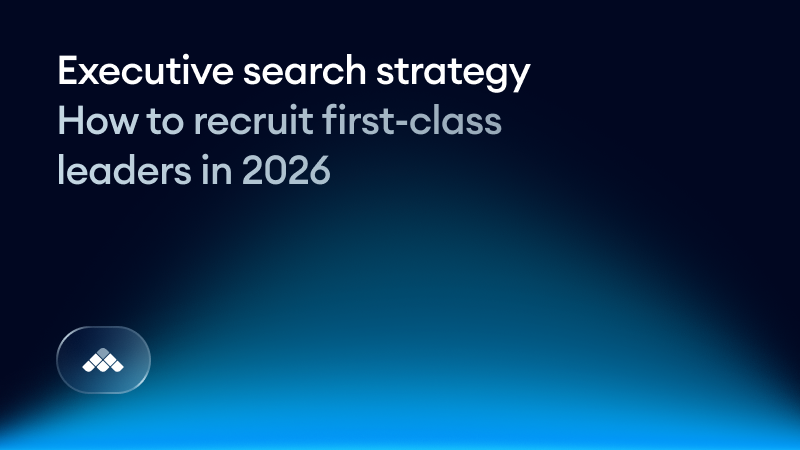Executive search has always been about precision, persuasion, and partnership. But with tight budgets and ever-present performance goals, the expectations keep rising.
Clients want data-backed insights, fast delivery, and measurable proof of performance. Candidates expect personalized, professional experiences, and will gladly walk away if you can’t deliver.
Recruiters must blend the human art of matchmaking with the science of automation and analytics. The modern executive search process goes beyond networks and intuition. You need AI, automation, and data to uncover better talent, build trust faster, and deliver results that align with business outcomes.
This guide explores what’s changing in executive search, outlines the key trends shaping 2026, and offers a practical, step-by-step strategy to modernize your approach.
3 key takeaways
- Executive search now relies on data and automation. Recruiters have unprecedented process visibility and efficiency without sacrificing personal relationships.
- AI-driven sourcing and assessment tools enable pinpoint targeting and evidence-based decisions for senior roles.
- The most successful recruiters are strategic advisors to both clients and candidates, using analytics and insight to guide toward smarter, faster outcomes.
What is executive search strategy?
Executive search strategy is the structured process of identifying, engaging, and hiring senior-level leaders—typically C-suite, VP, and Director roles. Compared with standard recruiting, it involves even deeper research, more personalized engagement, and longer-term client partnerships.
A strong executive search strategy ensures that every funnel stage is aligned with the client’s long-term goals, values, and culture.
What’s changing in executive search in 2026
What was once a relationship-driven, intuition-led craft is now deeply informed by data, technology, and automation.
Modern executive recruiters are more than talent scouts. They’re complete business consultants, expected to:
- Deliver data-driven market intelligence alongside strong candidate shortlists.
- Build trust through transparency, communication, and evidence-based recommendations.
- Manage sensitive candidate relationships and negotiations with confidentiality and care.
- Use technology to drive measurable efficiency and insight throughout the search.
Clients expect measurable results, fast delivery times, and transparent insights into how decisions are made.
Even more data-driven
Gone are the days when executive search relied on “gut feel.” Recruiters now use analytics to understand market dynamics, predict availability, and measure hiring velocity.
Data-backed insights help firms prove ROI, benchmark candidate quality, and optimize sourcing channels for long-term value.
More AI and automation
AI automates much of the manual research, data entry, and scheduling that used to slow recruiters down. From AI sourcing agents that find executives worldwide, to interview intelligence tools that summarize meetings automatically, automation lets recruiters focus on what matters most: relationships and results.
The most successful firms embrace AI to enhance human judgment, eliminate inefficiencies, and uncover talent that would otherwise remain invisible.
Fewer candidates; pinpoint targeting
The future of executive search is precision over volume. Recruiters now build smaller, curated shortlists using AI insights to evaluate fit, potential, and performance predictors.
The focus is on delivering must-hire leaders to clients. Not an endless list of maybes.
A 7-step executive search strategy
Building a future-ready executive search strategy means balancing trust and discretion with the speed and intelligence of modern technology. The following seven steps combine proven best practices with AI-powered tools, analytics, and automation workflows that define how elite search firms operate today.
Each step helps you find, assess, and secure top leaders more precisely, and more efficiently.
1. Define success and scope clearly
Every great search starts with a clear definition of success. Go beyond job titles and years of experience to identify the measurable outcomes your executive leader should achieve.
- Use analytics to benchmark the role against market standards: salary range, team size, and expected deliverables.
- Collaborate with hiring stakeholders to define must-have versus nice-to-have competencies.
- Apply structured scorecards and leadership frameworks to ensure alignment from day one.
How it helps: Clear, data-backed scoping prevents misfires, and ensures you’re targeting executives who can deliver the business impact your client expects.
2. Conduct deep market mapping and research
Traditional research methods relied on spreadsheets and manual tracking. Now, AI-powered market mapping gives recruiters an always-on view of the leadership landscape.
- Use sourcing tools that aggregate data from public profiles, financial filings, patents, and news articles to identify high-potential candidates.
- Predictive analytics can flag when executives are most likely open to new opportunities. For example, after funding rounds, downsizing announcements, or tenure milestones.
- Automation tools can track career movements across industries, keeping your data live and accurate.
How it helps: Instead of rebuilding lists from scratch each time, recruiters have a living, dynamic market map ready for any client need.
3. Build a precise sourcing and outreach plan
Sourcing has evolved from network-based to data-driven. AI sourcing tools let you search continuously and globally, even while you sleep.
- Prompt AI tools to find executives who match your client’s success profile, not just their job title. The best ones only need a job description, a few bullets, or even a voice prompt to begin.
- Automate outreach campaigns that personalize messages based on role, achievements, and shared connections.
- Use your ATS and CRM tools to track engagement, responses, and follow-ups automatically.
How it helps: A global executive search firm can easily use automated sourcing to cut shortlist times by 40%, while increasing candidate engagement through data-backed personalization.
4. Qualify and assess candidates rigorously
Senior-level interviews are complex and subjective, and typically require months of nurturing on both sides. Anything you can do to shorten these timelines is valuable.
Here, AI interview intelligence can be transformative.
- AI transcription tools capture every word of every conversation, removing the need for manual notetaking. That’s true for candidate interviews but also intake and debrief calls and client updates, too.
- Machine learning identifies themes in candidate responses, sentiment, and communication style.
- Structured rubrics ensure every interviewer evaluates candidates against the same leadership criteria.
How it helps: Recruiters can now compare candidates side by side using objective evidence, not intuition. Which leads to better placements and higher client satisfaction.
5. Manage client expectations and communication
Clients want visibility and delivery, not vague or unmet promises. Replace static progress updates with real-time data dashboards that showcase progress transparently.
- Track outreach volume, candidate engagement, and pipeline health using analytics tools.
- Automate weekly updates summarizing search status, response rates, and top candidate insights.
- Use data to shape conversations. Identify bottlenecks and predicting when offers are most likely to close.
How it helps: Position yourself as a consultative partner, not just a vendor, using data to drive credibility and trust.
6. Guide the candidate experience
High-level candidates expect seamless communication and respect for their time. And even if they don’t sign, you want to keep the best in your address book for years to come. So a smooth, enjoyable candidate experience is critical.
- Use automation for scheduling, reminders, and follow-ups, ensuring no step falls through the cracks.
- AI-powered tools can personalize messages based on candidate interests or previous conversations.
- Provide structured interview feedback and transparent timelines. Your professionalism strengthens your firm’s reputation and helps your clients stand out against other offers.
How it helps: The quality of the candidate experience directly reflects your client’s brand and your firm’s credibility. AI ensures that quality never drops, even at scale.
7. Analyze, learn, and refine
Prioritize continuous improvement. Every search generates valuable data on outreach, conversion rates, and placement success. Every accepted offer validates your approach, and every disappointment is a chance to get better. But you need the data to track along the way.
- Analyze which sources consistently deliver top talent.
- Use post-search reviews to identify process bottlenecks and efficiency gains.
- Feed this insight back into your sourcing and assessment frameworks for smarter, faster future searches.
How it helps: You create a self-improving system that compounds value over time, making each engagement more efficient and data-informed than the last.
How Metaview helps executive search firms
Metaview lets executive search professionals modernize their approach with AI-powered interview intelligence and sourcing automation. It captures data from every interaction, giving you the clarity and efficiency you need to deliver faster, higher-quality placements.
Here’s how Metaview supports executive recruiters:
- AI interview notes: Automatically record and summarize interviews, saving hours and improving accuracy.
- Automated sourcing: Identify top executive candidates automatically, based on role data and past success profiles.
- Recruiting analytics: Visual dashboards show pipeline health, time to close, and quality metrics for clients in real time.
- Bias reduction: Structured assessments ensure every candidate is evaluated consistently and fairly.
- Client-ready summaries: Instantly generate professional feedback reports and candidate insights for client presentations.
Metaview gives executive recruiters an edge, combining AI efficiency with human expertise to build lasting client trust and deliver measurable results.
- Katie Campbell, Vice President, Executive Search, JM Search

Redefine your executive search strategy for 2026
The future of executive search belongs to recruiting firms that combine technology, intelligence, and empathy. Data and AI enhance the recruiter’s role, so you can focus on relationships, strategy, and storytelling.
As clients demand faster delivery and more transparency, embracing automation and analytics is the only path to staying competitive. With the best executive search software, your staffing strategy becomes the best in the business.
Ready to modernize your executive search strategy? Try Metaview for free.
Further reading
- How Raines International leads the executive search world with Metaview
- How Riviera Partners enhance client & candidate calls with Metaview
- How top recruiting agencies use AI tools to close roles & win clients
Executive search FAQs
1. How is executive search different from standard recruiting?
Executive search focuses on leadership roles that require discretion, research depth, and relationship management. It’s a high-touch process, often involving multiple stakeholders and extended timelines.
2. What are the biggest technology trends in executive recruiting for 2026?
Automation, AI sourcing agents, and interview intelligence are the leading trends. They reduce time spent on manual research and notetaking, so recruiters can focus on candidate relationships and strategic advisory work.
3. How can AI improve candidate evaluation at the executive level?
AI analyzes interview transcripts, highlights leadership competencies, detects sentiment, and compares candidate responses against success frameworks. This ensures objective, consistent assessments across every search.
4. What metrics should executive recruiters track?
Track time to shortlist, candidate response rate, interview to hire ratio, and placement success rate. Analytics dashboards can help visualize these metrics in real time to demonstrate performance to clients.
5. How can executive search firms balance automation with personal connection?
Automation handles the operational work: scheduling, summarizing, tracking. Recruiters focus on the personal side: thoughtful outreach, deep understanding, and high-touch communication. The best firms blend both seamlessly.


